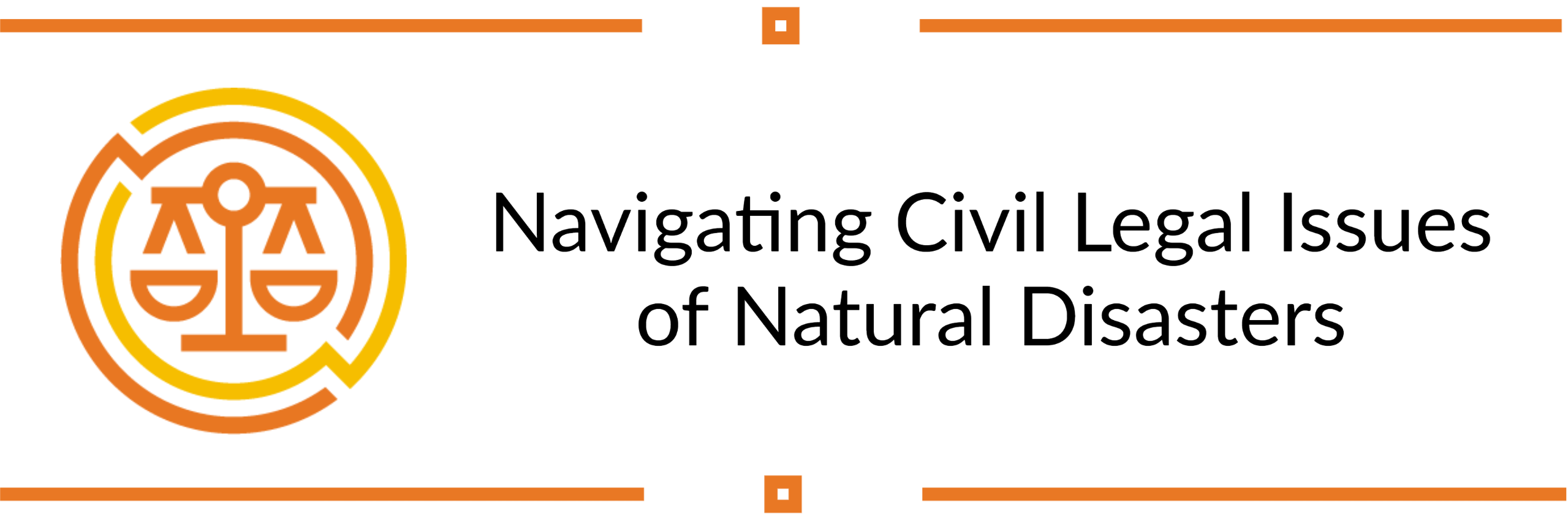Developed by: WebJunction, in collaboration with Legal Services Corporation
Estimated Time to Complete: 4 hours
Overview
The first course covers the basics of the Emergency Management Cycle and the civil legal issues that are likely to arise after natural disasters. It focuses on the importance of building your network of disaster responders well before disaster strikes – the Preparedness phase. It’s likely that your community has some level of emergency response planning in place, but do the key community stakeholders recognize the role the library can play when integrated into their planning cycles? This course introduces actions that the library and its staff can take to put resources, partners, and strategies in place, so that they can help patrons know what to expect and what to have on hand to support their civil legal issues that arise in an emergency. Learners will begin to compile a disaster response and recovery binder (DRR binder), a hard copy collection of reference resources that are the most critical information to access in case of a power outage.
Learning Objectives
As a result of taking this course, library staff will be able to:- Explain why it is critical to incorporate civil legal needs into a disaster response plan before crises occur.
- Recognize the civil legal issues that emerge in natural disasters and the timeline in which patrons are likely to experience them.
- Prepare a disaster resource collection, including referrals to disaster legal assistance.
- Cultivate relationships and partnerships with local and state disaster response agencies.
- Motivate their patrons to prepare for disasters.
- Create a technology plan to get library services restored in the face of disaster.
Developed by: WebJunction, in collaboration with Legal Services Corporation
Estimated Time to Complete: 6 hours
Overview
Course 2 covers the Response and early Recovery phases of the Emergency Management Cycle and continues the development of the disaster response and recovery binder (DRR binder) begun in Course 1. The first part of this course addresses trauma-informed care in the aftermath of disaster. The second part of the course covers the primary funding sources for disaster recovery, including insurance and government assistance, with their attendant legal complications. When disaster strikes a region, everyone feels the traumatic impact to varying degrees. It’s critical to understand how to respond with sensitivity to the turmoil a patron is experiencing (trauma response) before diving into connecting patrons with disaster assistance.
If the disaster is federally declared, the Federal Emergency Management Agency (FEMA) and the Small Business Administration (SBA) can provide government-funded individual assistance for a variety of crisis needs. Library staff can benefit from knowing basic information about the application and appeals processes, timelines, and dependencies of these assistance programs to be able to guide patrons to appropriate resources and adjust their expectations. Legal complications often arise in these processes, and library staff will benefit from having their list of legal referrals as part of the reference collection assembled in Course 1.
Learning Objectives
As a result of taking this course, library staff will be able to:- Apply a trauma-informed approach in response to disaster survivors.
- Explain the general processes and dependencies of the primary funding sources for individual disaster assistance in a major natural disaster: insurance, FEMA, and SBA.
- Guide patrons to information and resources that will help them navigate disaster assistance.
- Manage patron expectations about how disaster assistance can help with recovery.
- Recognize common issues associated with disaster relief (e.g., landlord-tenant problems, contractor scams, and price gouging) and refer patrons to legal assistance.
Developed by: WebJunction, in collaboration with Legal Services Corporation
Estimated time to complete: 2 hours
Overview
Course 3 captures the later phase of Recovery and delves into Mitigation. The crisis atmosphere may subside after six weeks or so, but the civil legal aspects of a natural disaster upheaval can extend well beyond six months. The experience of trauma is long-term. Issues around housing, finances, family, and education are all exacerbated by disaster and can take months, and even years to resolve. Scams and fraud connected to a disaster can continue for as long as there are potential victims. When library staff recognize the potential long-term impacts of a disaster, they will be prepared to provide information and referrals for legal issues that may emerge later. Library staff can also provide information about community mitigation efforts, which look for ways to prevent, lessen, or alleviate the adverse impacts of a disaster. The tactics are similar to preparation, but the key distinction is that mitigation steps happen after a disaster has already occurred. Mitigation is important because the best time to get people’s attention on preventative measures is right after a disaster when the experience is fresh.
Learning Objectives
As a result of taking this course, library staff will be able to:
- Recognize and respond appropriately to signs of long-term trauma as a result of natural disaster.
- Recognize and provide information and resources about long-term legal issues that persist months/years after a disaster.
- Connect with the emergency management community to participate in community mitigation efforts.
- Provide information and guidance about mitigation opportunities available for their communities and individual survivors.


